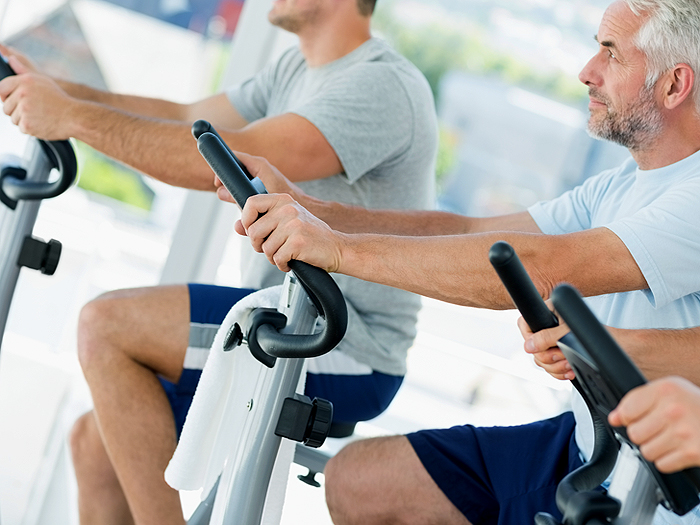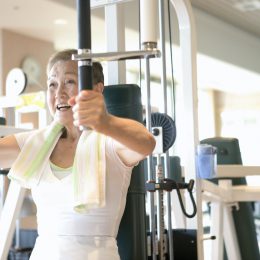Guía de máquinas cardiovasculares para principiantes
Tonifique su cuerpo y mente con estas alternativas a la caminadora.

If you're new to the gym, the row of cardio machines can be intimidating. Which one is best for you? How do you get started? How long do you really need to exercise?
Find all the answers you need to navigate your way around the cardio floor with this simple guide.
First, What’s the Benefit of Cardio Exercises?
This type of exercise gets your heart rate up, which improves blood flow and burns calories, says Stephen Lo Cicero, personal training manager at Blink Fitness in West Babylon, New York. With regular cardio exercise, you can lose weight and help lower your risk of heart disease, stroke, and diabetes.
Cardio exercise may also protect your memory and thinking skills. A study published in the European Journal of Applied Physiology found that regular aerobic exercise, the kind that gets your heart and your sweat glands pumping, appears to boost memory and brain function in older adults.
The key is to engage in moderate-intensity activity at least 30 minutes per day, five days per week. But if you’re just getting started, plan for 10 minutes per day for the first few weeks, and then work your way up. Anything that gets your heart pumping enough that you break a sweat counts, including walking, swimming, pickleball, dancing, or cardio machines at the gym.
Como siempre, la clave es la seguridad. Get your doctor’s OK before beginning a new exercise program. Si tiene una enfermedad crónica (incluida la osteoporosis), problemas de equilibrio o lesiones, hable con su médico para ver la forma de hacer ejercicios con seguridad.
Get and stay active with SilverSneakers! Classes and events are happening daily at participating gyms, online through SilverSneakers LIVE, and at community centers near you. Activate your free online account to get started.
Beyond the Treadmill: 3 Beginner-Friendly Cardio Machines
1. Stationary Bike
The bike is a good place to build up endurance so you can confidently move to a non-seated machine. "Your first workout should be about learning how to use the equipment and progressing," Lo Cicero says. You can use the bike to learn pace (how fast you're going), resistance (which adds a challenge), and intervals (alternating speeds).
Most gyms offer upright and recumbent stationary bikes. If you deal with any joint pain, start with a recumbent bike. The seated position with the pedals in front of you may alleviate pressure on your back, knee, and hip joints, compared to upright bicycles.
When you’re just getting started, press the “quick start” button and let the machine guide you.
Recommended FREE SilverSneakers On-Demand Workout: Workout to Improve Memory for Seniors
2. Elliptical
When you feel comfortable on the bike, try the elliptical without using the arms. Approach your first elliptical workout the same way as your first bike workout: slowly and with the goal of mastering the movement. You can add speed, resistance, and arm motions as you gain confidence.
"Cardio is a commitment to learning, so be patient," Lo Cicero says. As with the stationary bike, you can press the "quick start" button and let the machine guide you the first time you use it.
Recommended reading: 7 Ways to Make Your Elliptical Workout More Effective
3. Rowing Machine
¿Listo para un desafío? Check out the underappreciated rowing machine. "Even with high-tech cardio machines coming out each year, sometimes the oldies are the goodies," Lo Cicero says.
This machine requires both your upper body and lower body to work together. Because it requires more concentration and coordination, try it only after you've built some endurance on the bike and elliptical. It's also a good idea to ask a trainer for a quick tutorial.
Suscríbase a nuestro boletín informativo
Es rápido y fácil: Usted podría estar entre las 13 millones de personas elegibles.
¿Ya es miembro? Haga clic para descubrir nuestros más de 15,000 centros participantes.
Síganos
Most machines are user-friendly, but it's helpful to get instructions before you get started, Lo Cicero says. If you have any health issues, such as a bad knee, you can also discuss any modifications you should try.
Don’t Forget to Mix Things Up
It's important to stick with a machine until you master the basic movements, but once you have a regular cardio routine, you'll want to alternate the machines you use. This will help you avoid overuse injuries, which can occur if you're doing the same motions over and over, Lo Cicero says. Try to use at least two different machines each week.
It's also a good idea to continue challenging yourself with resistance or intervals so that you keep seeing results and avoid boredom. This can be as simple as alternating between one minute at a challenging speed and two minutes at a slow, recovery pace eight times total.
Recommended workout: Interval Cardio Workout using any two different cardio machines
See our sources:
How regular cardio exercise improves cognitive function: European Journal of Applied Physiology
Physical activity guidelines for Americans: U.S. Department of Health and Human Services
Verifique su elegibilidad para SilverSneakers al instante
SilverSneakers members can go to thousands of nationwide gyms and fitness locations, plus take SilverSneakers LIVE online classes that are designed for all fitness levels and abilities. If you have a Medicare Advantage plan, it may include SilverSneakers — at no additional cost. Verifique su elegibilidad al instante aquí.
Already a member? Get your SilverSneakers member ID and exclusive fitness and wellness content by activating your online account here.
¿No es elegible para SilverSneakers? todavía puede obtener gratis más de 200 videos de SilverSneakers On-Demand y mantenerse en contacto con nosotros, creando su cuenta en línea.





